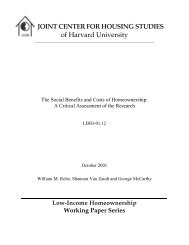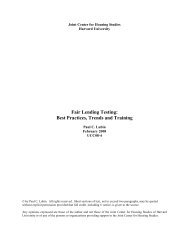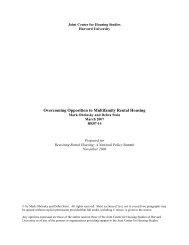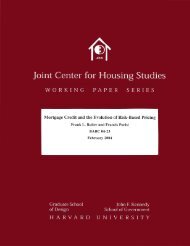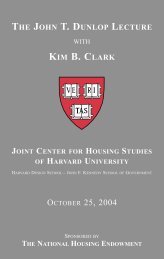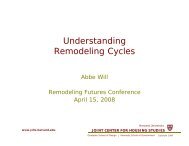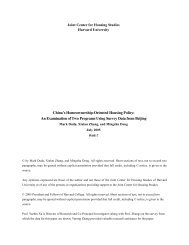please do not cite or circulate without permission of the authors
please do not cite or circulate without permission of the authors
please do not cite or circulate without permission of the authors
Create successful ePaper yourself
Turn your PDF publications into a flip-book with our unique Google optimized e-Paper software.
analysis <strong>of</strong> home sales in <strong>the</strong> vicinity <strong>of</strong> seven scattered-site public housing developments<br />
in Yonkers, New Y<strong>or</strong>k, and rep<strong>or</strong>t no impact on sales prices.<br />
Several recent and careful studies find that proximity to subsidized rental housing<br />
may in fact depress property values. Lyons and Loveridge (1993), Goetz, Lam, and<br />
Heitlinger (1996), and Lee, Culhane, and Wachter (1999) all find small statistically<br />
significant negative effects on housing value associated with <strong>the</strong> presence <strong>of</strong> subsidized<br />
housing in a neighb<strong>or</strong>hood.<br />
In sh<strong>or</strong>t, <strong>the</strong>re is no consensus about <strong>the</strong> effects <strong>of</strong> subsidized housing on<br />
surrounding property values. M<strong>or</strong>eover, in all <strong>of</strong> <strong>the</strong>se studies (as in those <strong>of</strong> private<br />
housing), data limitations make it difficult to pinpoint <strong>the</strong> direction <strong>of</strong> causality. Are<br />
subsidized sites systematically located in weak neighb<strong>or</strong>hoods <strong>or</strong> <strong>do</strong> subsidized sites lead<br />
to neighb<strong>or</strong>hood decline? Most <strong>of</strong> <strong>the</strong>se pri<strong>or</strong> studies utilize cross-sectional data and thus<br />
can<strong>not</strong> determine whe<strong>the</strong>r neighb<strong>or</strong>hoods with subsidized housing are systematically<br />
different from those <strong>without</strong>. 2 One recent study utilizes a research design that far m<strong>or</strong>e<br />
persuasively s<strong>or</strong>ts out causality to study <strong>the</strong> impact <strong>of</strong> neighb<strong>or</strong>s who use Section 8<br />
certificates and vouchers (Galster, Tatian, and Smith 1999). We b<strong>or</strong>row from <strong>the</strong>ir<br />
metho<strong>do</strong>logy, adapting it to study <strong>the</strong> development <strong>of</strong> new owner-occupied homes.<br />
Virtually all <strong>of</strong> <strong>the</strong>se earlier studies focus on rental housing; only two examine <strong>the</strong><br />
impact <strong>of</strong> publicly assisted homeownership programs. Lee, Culhane, and Wachter (1999)<br />
find that FHA-insured units and units developed through <strong>the</strong> Philadelphia Housing<br />
Auth<strong>or</strong>ity’s homeownership program both seem to have positive impacts on surrounding<br />
house prices. This is precisely <strong>the</strong> opposite <strong>of</strong> <strong>the</strong> study’s conclusions concerning rental<br />
housing (discussed above)—<strong>the</strong> Section 8 New Construction Program is <strong>the</strong> only rental<br />
housing program that appears to have a positive effect on property values. Although <strong>the</strong>se<br />
results seem to suggest that homeownership and new construction have uniquely positive<br />
effects on surrounding property values, a m<strong>or</strong>e recent study raises <strong>do</strong>ubts. In <strong>the</strong>ir study<br />
<strong>of</strong> Nehemiah housing developments in Philadelphia, Cummings, DiPasquale, and Kahn<br />
(2000) find no evidence <strong>of</strong> spillover effects <strong>of</strong> <strong>the</strong>se new owner-occupied homes on<br />
surrounding property values. 3<br />
2 Briggs, Darden, and Aidala (1999) utilize longitudinal data but <strong>the</strong>y <strong>do</strong> <strong>not</strong> control f<strong>or</strong> bef<strong>or</strong>e and after<br />
price trends in <strong>the</strong> neighb<strong>or</strong>hoods surrounding <strong>the</strong> public housing sites.<br />
3 As discussed above, many argue that an increase in <strong>the</strong> prop<strong>or</strong>tion <strong>of</strong> homeowners should in itself bolster<br />
3



